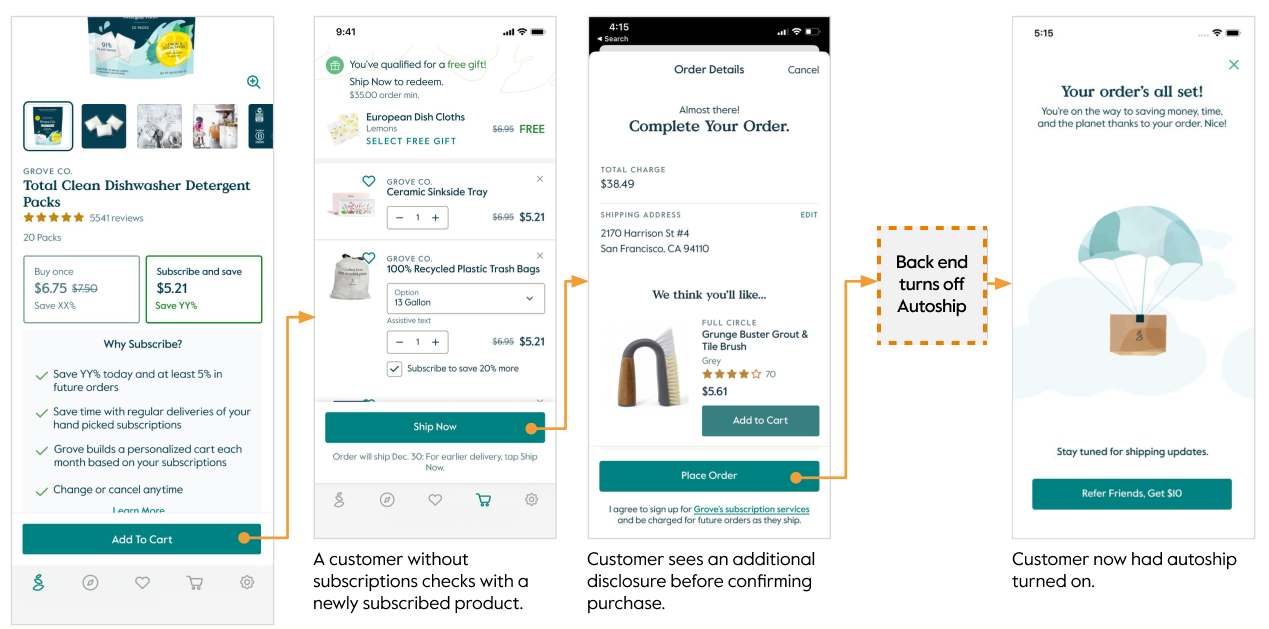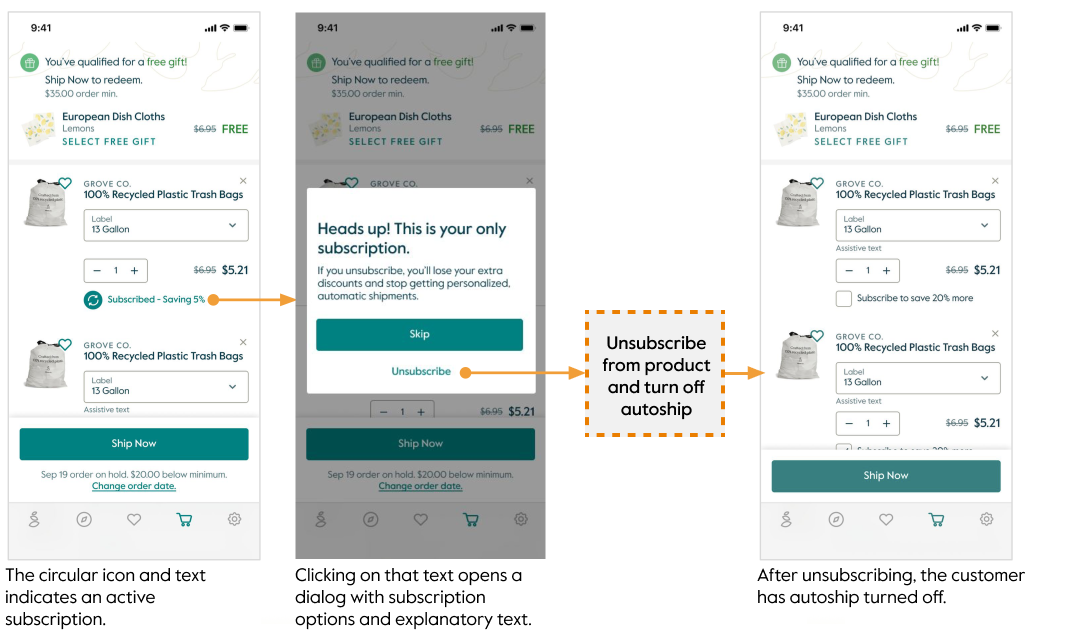Grove Autoship Consolidation
Simplifying subscription management to reduce customer pain.
Project Goal
Consolidate separate subscription controls into in one easily understood mechanism.
My Contribution
• Product Designer
• User research and testing
• Stakeholder Workshop Facilitation
• Executive Communication
Team
• Product Manager
• iOS Engineers
• Android Engineers
• Back End Engineers
• Technical Marketing Partners
Background
Grove is a sustainable home and body care ecommerce platform that enables subscriptions to products we all use like hand soap, surface cleaners, dog treats, and face cream. Most customers use Grove’s subscription service in the following way:
Customers browse for, buy, and subscribe to products.
Grove puts those products in the customer cart at a regular cadence.
Grove automatically ships them to you.
Customers save trips to the store and get sustainable necessities on their doorstep. Hooray!
The Customer Problem
Grove developed its own subscription technology with separate controls for product subscriptions and automatic shipments (autoship). While this worked reasonably well as the company scaled, it unfortunately led to persistent customer confusion, partly due to the common understandings of the word ‘subscription’ and the multiple customer states this system required.
The Business Problem
Because Grove is a subscription-based business, any changes that affect subscription or shipment logic are extremely delicate. Even small downward changes in shipment rates could be catastrophic when annualized. It was critically important to make it simpler to unsubscribe but also be careful not to unintentionally put downward pressure on shipment rates.
Let’s look at the subscription controls more closely. Because of the separate product subscriptions and autoship controls, as a customer at Grove I can have any combination of two binary states be true:
I can be subscribed or not subscribed to one or more physical products
I can have autoship on or off at my account level
This results in four possible states for any user:
| Autoship On | Autoship Off | |
|---|---|---|
| Subscribed to product | Subscribed, Autoship On | Subscribed, Autoship Off |
| Not subscribed to product | Not Subscribed, Autoship On | Not subscribed, Autoship Off |
Two of these states make intuitive sense:
Subscribed, Autoship On These customers are the most engaged, best Grove customers. They order the same products regularly, and generally love to explore the catalog and tell their friends.
Not subscribed, Autoship Off These are churned customers.
Now let’s look at the other states. This is where things get a little weird and expose the UX and technical challenges.
Subscribed, Autoship Off This means customers are subscribed to a physical product but do not get regular shipments of them. We validated in user testing that this clashes with the common understanding of the term ‘subscription’.
Not subscribed, Autoship On These customers get a cart built for them every month….but it’s empty! This is quite unique to Grove and provides no use value to the customer nor the company.
This model required separate UI for product subscriptions and autoship, housed on separate pages. It also brought up a few thorny, almost paradoxical questions such as “what does it mean to have a subscription to something if I don’t get it shipped to me?” or “how can I have an order with nothing in it?”
In the legacy experience, customers had to control Autoship and product subscriptions on separate pages, creating a complex array of management options.
These questions translate into engineering cost (state management, lines of code) and even worse, complexity for the customer!
Throughout hours of interviews with our research team and reading through dozens of support transcripts, we heard many customers say they had trouble finding the separate autoship controls or, even worse, received unexpected charges and shipments at their door. When we dug into this confusion, a surprising insight emerged: customers think about buying products but Grove was built to sell shipments.
This tension emerged as a classic case of the business model and customer mental model being at odds. This inspired me to campaign a simple conceptual solve: make product subscriptions the mechanism for autoship status. That way, if I am subscribed to one or more products I am on the autoship program. If I have no product subscriptions, I am telling Grove I don’t want automatic shipments.
By user testing various subscription UI models, I developed strong conviction that the design could deliver the message of subscription state instead of relying on explanatory copy and help pages.
This shift brings us from four customers states to just two:
Subscribed customers get automatic shipments.
Unsubscribed customers do not get automatic shipments.
Checking out with a subscription intent now turns on autoship.
Unsubscribing from all products now turns off autoship.
Results
Because Grove is primarily a subscription business, this change had the potential to impact critical metrics like reorder rates, order values, and subscribed customer counts. No change in those metrics was an indicator of success, since we did not want to interrupt the status quo shopping habits. Therefore it was important to A/B test the new experience, let it run and compare the resulting data.
We tested on a full 50% of the customer base. Given the stakes, we were happy to learn that the new subscription design did not impact the primary KPI nor the most important secondary KPIs. Metrics like reorder rates, order frequencies, and order values saw no statistically significant change – definitive proof of the success of the new system. I’ve never been so happy to see flat results.



